In this lesson, we will talk about Microsoft Search Ads. (formerly known as Bing)
WARNING: This is a very long lesson.
Microsoft Search Ads
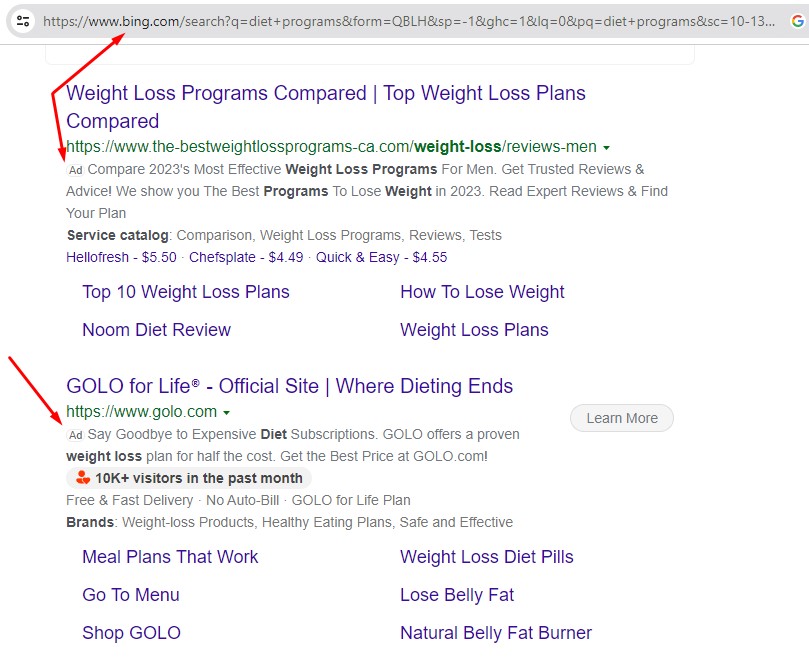
Microsoft is one of the best places for newbies to start in paid traffic. Here is a successful affiliate marketing campaign that was run on Microsoft ads, and it is still highly relevant today. Think of program like Fubo or other TV streaming affiliate programs.
This life-changing campaign used a sports landing page much similar to the one we have inside the templates library.
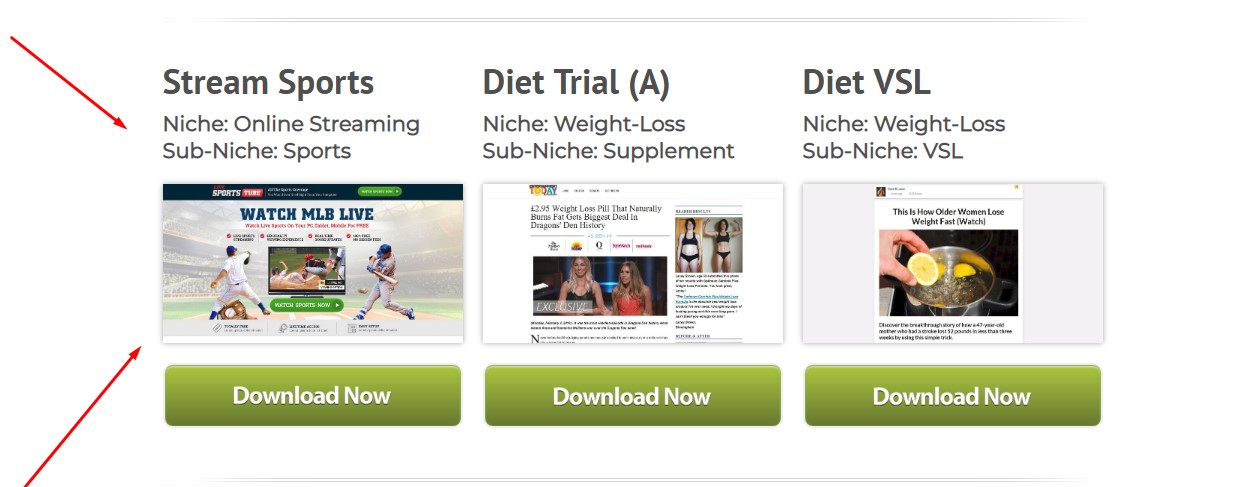
How This Streaming Campaign Worked Out:
On Sunday in the United States, a lot of people have a desire to watch an NFL game, and this often leads to an online search for viewing options. After some research we found an affiliate offer that had access to NFL viewing, sparking curiosity and a decision to reverse-engineer it.
Initial efforts saw a loss in the first week due to continuous ad running. However, utilizing CPV Lab Pro for precise tracking enabled campaign optimization.
Data analysis showed that most conversions occurred on Sundays between 2 p.m. and 10 p.m. EST, and also during Monday and Thursday night football broadcasts.
This insight led to a strategic decision to schedule ads precisely during these high-conversion windows, resulting in a profit of $1,000 the following week.
Microsoft Search Ads, is a component of the Microsoft Advertising platform, and it presents a great opportunity for affiliate marketers looking for alternatives to Google Search Ads. Microsoft Search Ads can offer lower cost-per-click rates.
After much Testing Here is What We Know About Microsoft Search Ads:
- Audience Demographics: The Microsoft Search Network tends to attract an older demographic, which is beneficial for certain products or services.
- Keyword Strategy: Thorough keyword research is essential. Tools like SEMRush help find high-value keywords at potentially lower costs due to reduced competition.
- Ad Copy and Relevance: It is crucial to create compelling ad copy that matches user intent, and ad relevance significantly affects placement.
- Quality Score: Focusing on ad, keyword, and landing page relevance can improve performance and reduce costs.
- Effective Landing Pages: Conversion-optimized landing pages should be congruent with ad copy and user intent.
- Campaign Management: Continuous performance monitoring and optimization are vital, with a specific emphasis on blocking ineffective web placements now that they include the audience ads in the search campaigns.
- Bidding Options: Testing Microsoft’s bidding strategies can improve success while managing expenses.
- Ad Extensions: Using ad extensions can boost click-through rates.
- Use Negative Keywords: Using negative keywords helps avoid irrelevant search matches, saving budget and improving ROI.
- Understand Microsoft’s Policies: Ensuring compliance with Microsoft’s advertising policies is crucial. They can be quick to ban accounts.
- Budget and Scale: Microsoft Ads’ generally lower CPCs allow for more efficient budget use.
For those new to affiliate marketing, Microsoft Ads is recommended for its affiliate-friendly environment. Starting with a focus on 10 to 20 keywords allows for manageable budgeting and traffic monitoring. With a low initial testing budget needed it provides an accessible platform for campaign experimentation.
To explore what others are doing, a simple search on Bing.com for trending keywords can reveal how other marketers are positioning their ads, offering ideas into effective advertising practices on the platform.
Let’s Share An Example:
Searching the Keyword: “Weight Loss”
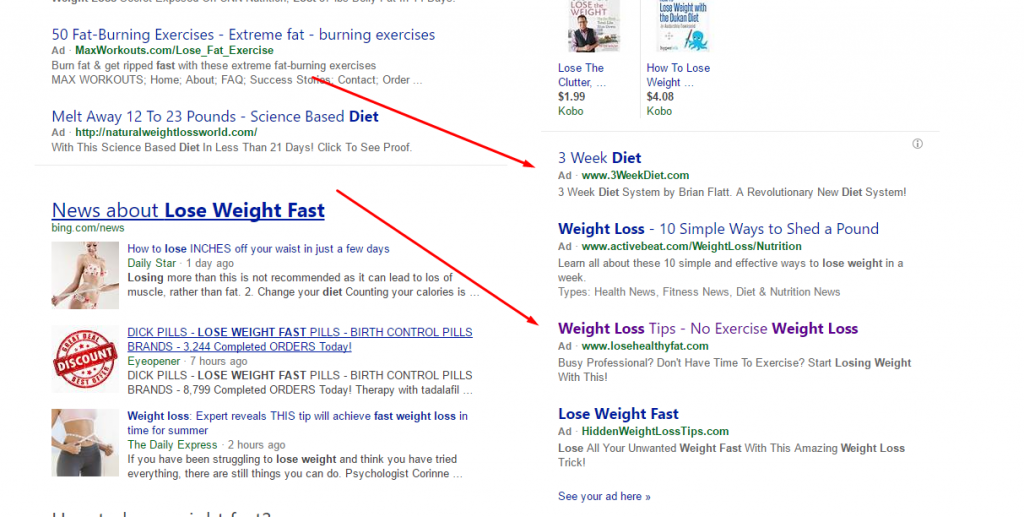
Reveals image above (3-week diet), you will be directed toward the landing page. This is an affiliate direct linking to an offer they got from Clickbank.com.
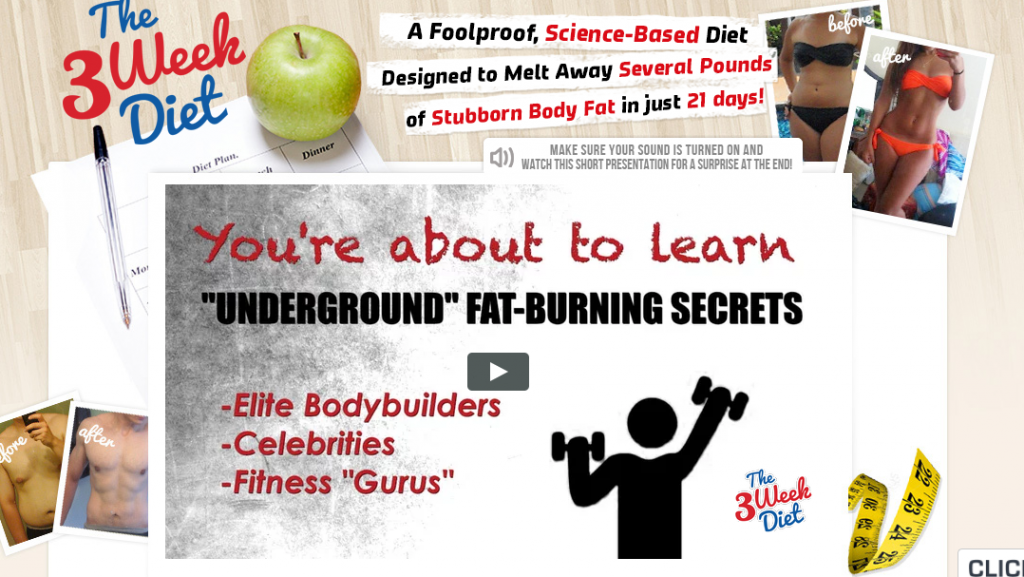
This marketer is directing their PPC ad toward their affiliate link. If we go on ClickBank itself, we can easily find this product to verify this theory:
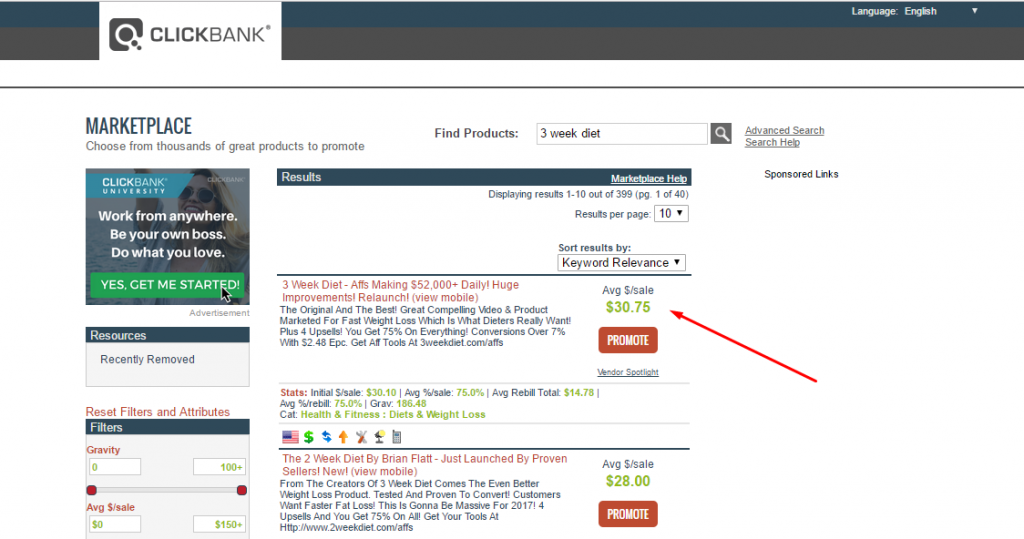
This marketer has chosen a product to promote and used his/her affiliate link to set up a search ad to promote that link.
IMPORTANT: We recommend you use landing pages for your own website – or you risk the chance of getting banned!
Promoting a Squeeze Page
Let’s look at another type of link promoted by a Bing.com pay-per-click ad. This time, a squeeze page. Again, search for “free diet ebook” in Bing.com and click on the following result from the ads section:
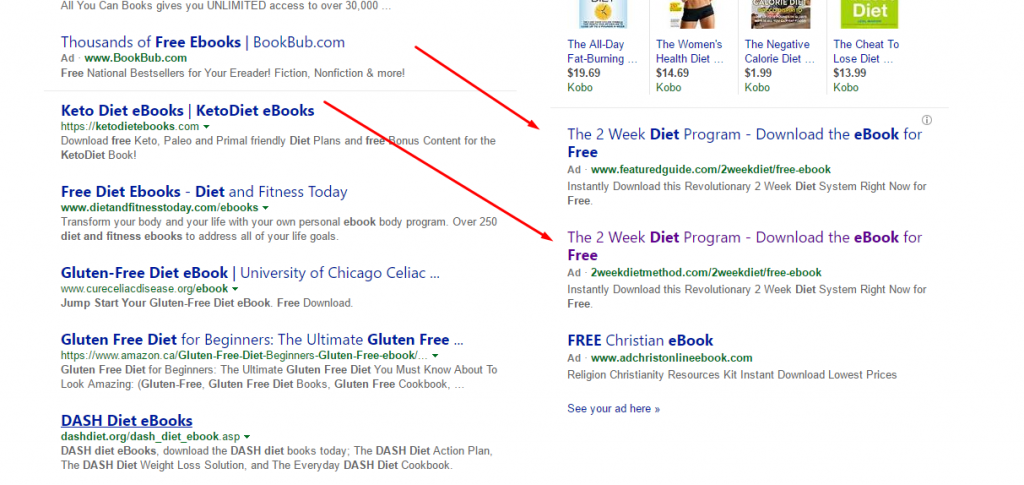
If you click on this ad, you will be redirected to the following squeeze page:
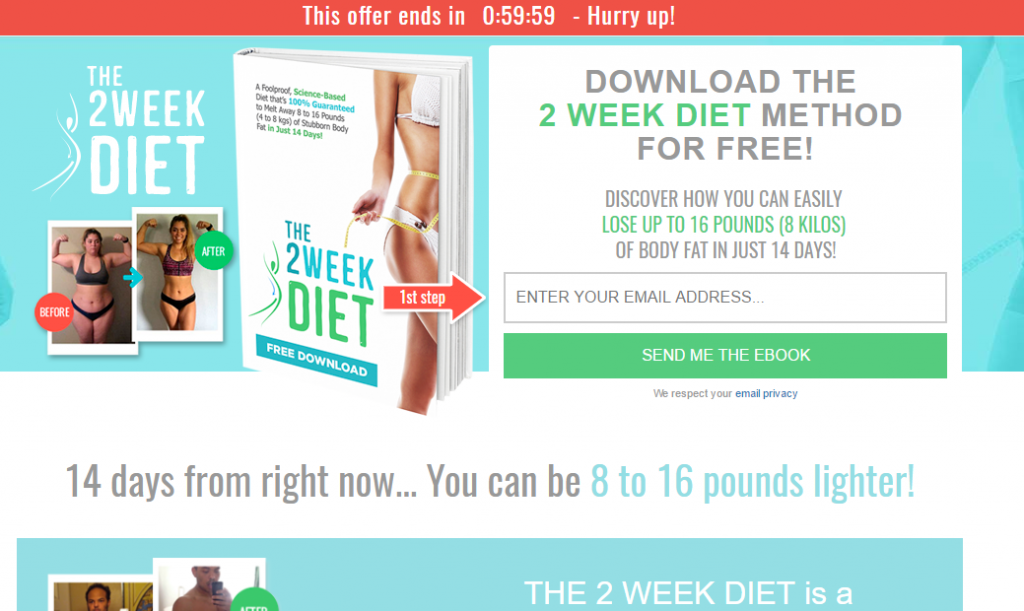
Do you see the big, beautiful “Send me the Ebook” button? When you click it, you must enter an email for these free guides. With your email in their database, they can send any of the products they are offering, even a “tripwire” offer.
This approach is a long-term strategy and can make you a lot of money, but it requires hard work.
Setting Up Ads: STEP BY STEP
You will be limited to certain offers when using PPC Search traffic. It’s important to understand that Microsoft Ads only allows certain types of offers to be promoted.
Read their guidelines for a better understanding of what is and is not allowed.
CPA offers can work well, and affiliates often have the best luck using lead generation offers or offers that don’t require a hard sell. (check out the Microsoft/Bing Ads case studies.)
Action Step 1: Choose an Offer From Your Affiliate Network
Lead gen, downloadable offers, insurance, loans, mortgage, dating, As Seen on TV Offers, Watch TV, Diet, Skin Care, E-commerce, Branded niches, etc.
These are all great niches for Microsoft Traffic.
Set aside 1 hour and pick roughly three offers you think you’d like to promote. You’ll need to find offers that:
– Allow PPC
– $15 payout or more is a general rule of thumb, but sometimes I will choose lower payouts.
Always Start With 1 Campaign
Don’t try and test too many campaigns all at once, especially if you’re starting to learn how to organize your campaigns. It can be a lot of work to optimize just one new campaign.
Action Step 2: Build Your Landing Page
Pro Tip: If you are establishing your website as a brand and multi-channel business this landing page should be part of your website and optimized for SEO in addition to being optimized for direct selling. It is believed that this will improve search rankings and engagement which Google uses as a ranking factor. Google will start seeing activity on the website/landing page through Google Analytics.
Always use a landing page or squeeze page for 3 more reasons:
1. Conversion rates are better with a presell landing page.
2. You can gauge the effectiveness of your ads by analyzing the landing page click-through rates.
3. You can build a large list of emails (especially using the LP “hack” we explained in the CPA course and you can start earning more money using tips from our Email Course.).
Action Step 3: Set Up Your Tracking
Go through the training on whichever platform you use for 3rd party tracking.
Action Step 4: Set Up Your Microsoft Ads Account & Advertisement
You need to go to Microsoft ads and set up your account. Search for promos to see if they have a bonus for new members or contact their support and ask for one.
General Ad Settings
Let’s point out some important settings.
Objective:
When you first create a campaign, it will ask about your goal. Choose conversions if you want conversions.
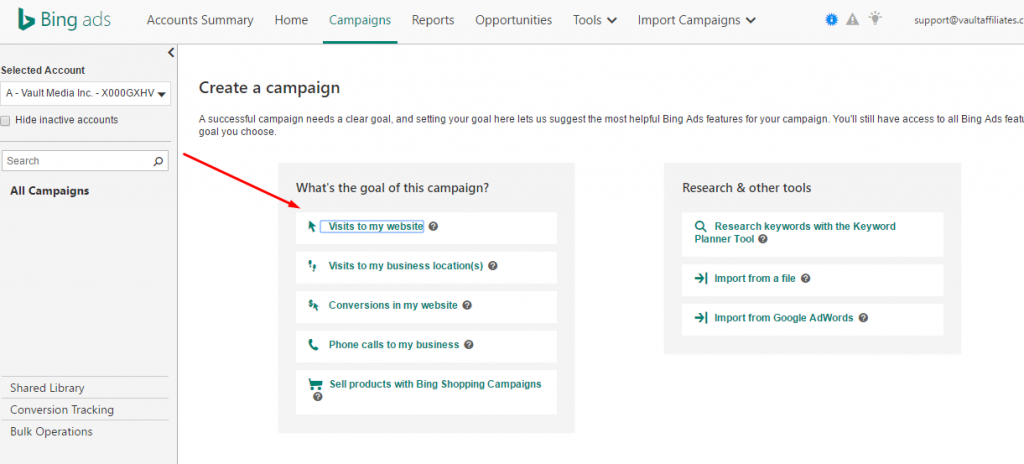
Campaign Budget
If you have a low budget $25 daily budget should be fine. You can increase budget once it’s working.
In “Daily Budget Options,” it is now set to spend your money throughout the day.
Country
Always set the country to the appropriate country that is allowed for the offer you are running. You will get this information from your offer details in the affiliate network you are on.
Advanced Location Options
Make sure to choose “people in your targeted location.”
Keywords
SEMrush tool is excellent for discovering what competitors may be bidding on. With a low budget, 10-20 KWs would be sufficient.
TIP: Watch our case studies for Bing.com and Google to learn some tricks for finding good keywords!
Bidding
It’s recommended to begin with enhanced CPC bidding. ($.30-$.50 to start – sometimes over $1-$3 if it’s a competitive niche). this also highly depends on what your Target Cost Per Conversion is.
Eventually, after you have about 20-40 conversions showing in Microsoft Ads, you may switch to Target CPA. (see CPV Lab documentation for posting conversions to Microsoft)
It’s better to start your bids higher and slowly lower them.
Your ad rank is partially based on your ad click-through rate (CTR), so if you want to get a lot of impressions and clicks, you need to be high up on the page.
If you are too low on the page, you will get high impressions and low clicks.
Ad position in Bing.com is crucial.

Devices
Unless the offer is optimized for mobile, which some are, always run all devices, including desktop, tablets, and mobile devices, for initial tests. You can see in reports which devices are converting best and adjust this setting later.
Adding More KWs
If you are bidding for conversions the ad platform will start to adjust and try to get you more conversions. Test the keywords, and review the search terms reports, before deleting and adding more. You can add several thousand keywords to target if you want, but your budget will be spread more.
Action Step 5: Examine Initial Launch Results
Once you launch the campaign, you might find many keywords that get no clicks and some that get a lot of clicks but with no conversions. It’s essential to get enough data before deleting any KWs. You can see all your data in the CPV lab reports and on Microsoft ads.
You need to consider many variables before deleting a KW from your Bing campaign.
No Impressions
Weed out KWs with no impressions, but first, you need to figure out why it gets no impressions. Impressions mean people have seen your ad but haven’t clicked on it.
Microsoft Ads decides when your ad is shown based on several factors, and if you’re not getting impressions, it could be due to the landing page or ad quality score, the amount of your bid, or the keyword not being searched.
If you leave these KWs in your campaign, they only serve to hurt you since it is factored into the budget equation that Microsoft ads use to determine your amount of impressions for the day.
Lots of Impressions and No Clicks
In Microsoft ads, you can easily see the ad’s CTR. This tells you which ad is more appealing to searchers. It is important to ensure that your ads match what the searcher wants. Microsoft ads will reward you with more impressions and cheaper clicks if you have a good CTR on your ads. If your ad is in a lower position, you will not get any clicks. It may be worth it to raise your bids to improve CTR. Change the wording to test variations of your ads. Sometimes this is all it takes to improve CTR.
Lots of Clicks and No Conversions
This means that you need to examine what happens after the user clicks on your ad and ask yourself a few questions:
Are they clicking through to the offer from my landing page at a decent rate?
If so, the offer may not match your landing page and ad. If not, then your landing page needs to get a higher click-through rate. You need to try different headings, wordings, images, colors, link positions, etc., and continue testing.
Is there consistency in what the ad offers, what you say on the landing page, and what the offer is?
If everything is consistent, then maybe the keyword is a dud. If it is not consistent, you need to test a new landing page and make it more consistent with the offer page.
Would this keyword do better in its own targeted campaign?
Here is where many marketers make the mistake of giving up too soon on a keyword. If you see that a KW is getting a lot of volume but no conversions in your original campaign, it may be worth making a separate targeted campaign for that keyword only.
You can even test different offers and try to get in the mind of the searcher, giving them exactly what they want when they search that KW. This is much better than deleting these keywords from your campaign forever.
Keep a file of all the keywords that get high volume, and sometimes you can refer to that list for campaign ideas.
Lots of Clicks and Lots of Conversions
Woohoo!
This is what we want.
When this happens, sometimes the best thing is to ride it out for a bit, raise your budget as much as possible, and bank as much money as possible.
It may help to delete all the non-performing KWs from the campaign and leave it as profitable as possible with a maxed-out budget. Then start a completely new campaign for testing another round of KWs. This is an excellent route since Microsoft Ads is very unpredictable in how they divide up your daily impressions.
Scaling
Once you find profitable keywords, examine them and consider why they are profitable. Use KW tools to find more variations and similar KWs. Then separate this KW into a cluster of similar keywords. Set up the clusters of keywords into their own ad groups.
Everyone is different in how they organize their campaigns. Many will agree that setting up ad groups within each campaign for each keyword cluster is easier.
Action Step 6: Optimization
Separate optimization tasks into 5 critical areas of analysis.
1. Keywords
2. Ads
3. Landing page
4. Offer
5. Traffic Source
Get at least 100 offer clicks worth of data before optimizing any of the areas above. The biggest mistakes in PPC are quitting too soon on a KW, not knowing when to quit, or not knowing which area of analysis is making the campaign unprofitable.
Keywords Analysis
The success of a PPC campaign is primarily based on keywords, as the keywords draw in traffic. Most Internet users enter a search string to find information.
If you target keywords (as you do in a search campaign), target only those KWs that are relevant to your offer and landing page. You have to imagine what keywords the target audience is likely to use.
Use the keyword tools to understand which keywords are most used, incorporate them in your campaign, and test. Check out our Power Hour sessions on spying in the forum.
Ads Analysis
Examine your ads both in your own tracker and Microsoft ads. Aim for a CTR of 5% or above in Microsoft ads. You can improve this with better headlines and ad wording.
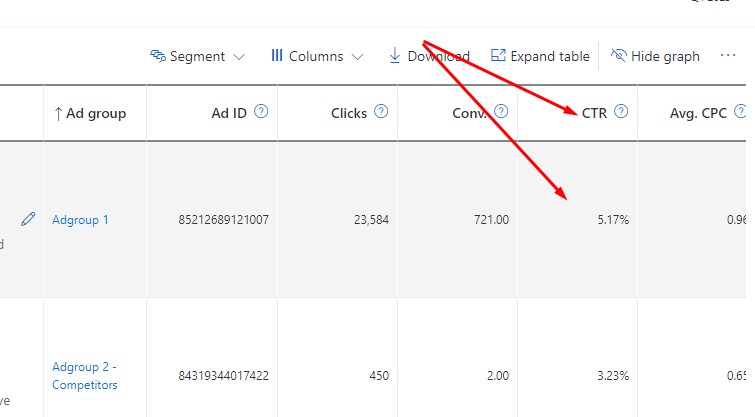
Landing Page
The last thing to check is landing pages. You should constantly split test landing pages.
Test all linking scenarios and settle with the one that makes the most profit. If your goal is long-term profit for a campaign, collect leads and send them through a sales funnel. (example shown in the CPA Marketing Course)
Action Step 7: Scaling
If you have a PPC campaign that works well, examine the best KWs and then start clustering them into separate ad groups. Inside the ad group, use all similar KWs and bid on all match types. This will increase traffic. Please refer to the Microsoft ads documentation for more information on match types and ad groups.
Next, consider moving your campaign to other traffic sources.
Action Step 8: Deciding When To Stop the Campaign
Expect at first that your campaigns will be unprofitable.
It will likely take a lot of practice and testing to find something that works for you.
Knowing when to stop a campaign can be very difficult. Even experts have a hard time. It is always a tough decision. Before quitting, make sure you have thoroughly tested all five parts of the campaign to ensure you didn’t miss anything (Ads, Keywords, Landing Page, Offer, Traffic Source).
Sometimes you just know that an offer won’t work; it is a gut instinct telling you to move on. Other times, you get lucky, and campaigns are profitable on day one.
Here are a few things that might help you make a decision:
- Make sure your decision is based on enough data.
- Make sure you test the campaign on all days and times and examine if there is a good time to run it.
- If the ads, KW’s, landing page, and offer are consistent, and you’ve tested each variable with enough data and time, and you are still losing money, it may be time to try a new campaign or traffic source.
- If none of the above work, you might want to try a new campaign.
Don’t give up after failing a PPC campaign. Finding profitable campaigns can be tough, but trust me, there is still a ton of money to be made, and it will always be a viable traffic source for Affiliates. You can get a lot of volume on Microsoft ads alone, so don’t underestimate it.

Comments are closed.